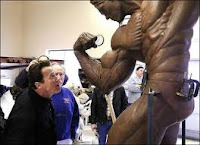Intermittent Thoughts on Building Muscle: A Preliminary Conclusion - Exercise, mTOR/AKT/MAPK, IGF-1, Testosterone, Estrogen, DHT, Nutrition, Supps & Sleep
 |
| Image 1: Arnold obviously is flabbergast that neither of the factors mentioned in the title of this blogpost was necessary to build the impressive physique of the Arnold statue which now stands in front of the Schwarzenegger Museum. |
Learn about the best muscle building exercise at the SuppVeristy
You will probably also remember that myostatin, the legendary TGF beta protein that acts as an inhibitor of muscle growth, is something like a watchdog, who suppresses further increases in myonuclear domain size, when the latter begins to exceed a presumably fiber-type dependent maximum - with highly oxidative type I (slow twitch fibers) exhibiting less growth potential than their glycolytic (fast twitch) cousins. From analyses of muscle fibers from different athletes, we do yet know that the skeletal muscle of bodybuilders, the epitome of maximal skeletal muscle hypertrophy, are not - as some people argue - characterized by an abundance of ultra-fast highly glycolytic type II fibers (cf. figure 1). |
| Figure 1: Fiber composition of bodybuilders, recreational lifters, endurance rowers and sedentary control; determined via myosin heavy chain (MHC) isoform content of the triceps brachii muscle (data adapted from Jurimäe. 1997) |
Protein synthesis + satellite cell recruitment = growth!?
You probably did not realize it, but with the brief reference to the recently published study on the effects of the exercise induced release of serum response factor (Srf), the subsequent reminder of the difference in the increase in myonuclear domain sizes and the increase in their number and the allusion to training (and drug) induced changes in fiber-composition, we have covered the fundamental mechanisms by which the scrawny boy on the left side of image 2 turned into a, if not the, figurehead of physical culture and bodybuilding.
 |
| Image 2: The fundamentals of skeletal muscle hypertrophy apply to us all. |
-
IGF-1 and its Splice Variants MGF, IGF-IEa & Co - Are the growths hormones master regulators of muscle growth or just a bunch of cogs in the wheel of skeletal muscle hypertrophy?
- IGF-1, TNF-α, IL-15 & Co and the Emerging Role of an Auto-/Endocrine-Immune Axis in Skeletal Muscle Hypertrophy - How does inflammation factor in, is it beneficial or detrimental?
-
Zoning in on "The Big T" - Does testosterone (alone) build muscle?
- Quantifying "The Big T" - Do increases of testosterone, which are well within the physiological range matter?
- Understanding
the "Big T" - How does testosterone work? What is its effect on stem cells and how come it makes you leaner?
-
Estrogen, Friend or Foe of Skeletal Muscle Hypertrophy? - Which role does estrogen play and why could you SERM away your growth potential, when you (ab-)use tamoxifen or potent aromatase inhibitors?
- Dihydrotestosterone (DHT), The All Things Male Hormone - Will it make you bigger, stronger and faster or just balder, fatter and unhealthier?
A picture is worth a thousand words - tying the knots graphically
For those of you who either remember all that or have just returned from their virtual tour through the archives of the SuppVersity, I have come up with a graphical illustration which is an attempt to sum up "all" the major players and their interactions.
If you can show me another player in this orchestrate with a similarly or even more important function than physical activity with a focus on skeletal muscle overload, let me know... if not, you better make sure you do not miss your next workout ;-)
If you can show me another player in this orchestrate with a similarly or even more important function than physical activity with a focus on skeletal muscle overload, let me know... if not, you better make sure you do not miss your next workout ;-)









